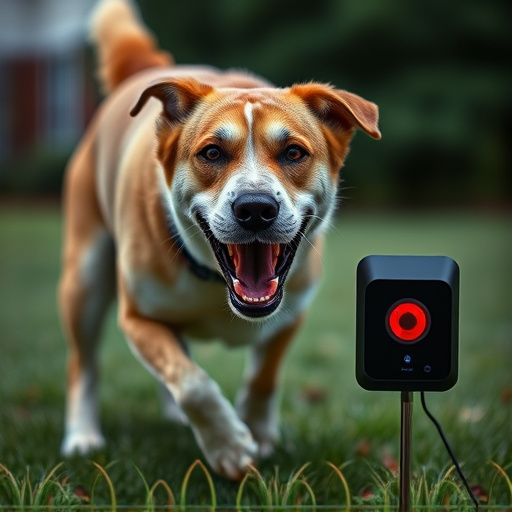Excessive dog barking can range from a nuisance to a sign of distress, but understanding triggers and using non-lethal solutions like FDA-approved dog repellent devices—which employ sound, vibration, or scent technologies—can help. These devices, combining positive reinforcement training with mild discomfort, disrupt barking patterns without harming dogs. Proper selection is key, focusing on safety features, adjustable frequency settings, diverse training modes, automatic shut-off, user-friendly design, waterproofing, and manufacturer support for long-term effectiveness and pet well-being.
“Unleash a quieter, more manageable pet dog with the help of Electronic Bark Prevention Devices. These innovative tools offer a humane alternative to traditional methods, addressing the root causes behind excessive barking. In this comprehensive guide, we explore the science and safety behind these devices, backed by FDA approval, ensuring their efficacy for pet use. From understanding canine behavior to choosing the perfect device, discover how to transform your dog’s barking into a symphony of calmness with our in-depth look at FDA approved dog repellent devices.”
- Understanding Dog Barking: Causes and Behavior Patterns
- The Science Behind Electronic Bark Prevention Devices
- FDA Approval: Ensuring Safety and Efficacy for Pet Use
- Choosing the Right Device: Features and Considerations for Effective Training
Understanding Dog Barking: Causes and Behavior Patterns
Dog barking is a complex behavior that stems from various triggers and emotional states. Understanding why dogs bark is essential when addressing excessive or unwanted barking, which can be both a nuisance and a sign of distress. Causes range from basic needs like hunger, thirst, or desire for attention, to more complex issues such as fear, anxiety, or territorial behavior. Recognizing these patterns helps owners identify the root cause of their dog’s barking.
Electronic handheld devices designed for bark prevention, including FDA-approved dog repellent devices, offer non-lethal solutions by utilizing sound, vibration, or other sensory stimuli to deter barking. These tools can be effective in modifying behavioral responses, especially when combined with positive reinforcement training. However, it’s crucial to choose products carefully and consult with professionals to ensure they are suitable for a dog’s well-being and don’t cause further stress or harm.
The Science Behind Electronic Bark Prevention Devices
Electronic bark prevention devices have gained popularity as a humane and effective solution for managing canine behavior. These innovative tools use sound, vibration, or even scent to deter excessive barking without causing harm to the dog. The science behind their functionality lies in stimulating the dog’s senses and modifying its behavior through positive reinforcement or mild discomfort.
The FDA Approved Dog Repellent Devices are designed with a deep understanding of canine psychology. They emit specific frequencies or patterns that capture the dog’s attention, interrupting the barking pattern. Some devices use ultrasonic sounds, which are inaudible to humans but irritating to dogs, while others employ vibration or spray technology. These methods aim to discourage barking without resorting to punishment, making them a preferred choice for responsible pet owners and animal behavior experts alike.
FDA Approval: Ensuring Safety and Efficacy for Pet Use
The development and use of electronic bark prevention devices for pets, especially dogs, have grown significantly in recent years. However, it’s crucial to remember that not all products on the market are created equal. The Food and Drug Administration (FDA) plays a vital role in ensuring the safety and efficacy of pet care products, including bark repellent devices. FDA Approved Dog Repellent Devices undergo rigorous testing and evaluation to meet specific standards for animal safety and performance.
This regulatory oversight is essential as it safeguards pets from potential harm caused by poorly designed or ineffective products. By ensuring these devices are FDA Approved, pet owners can have confidence in their effectiveness while also minimizing risks associated with unwanted side effects. This approach fosters a responsible and ethical market environment for pet care solutions.
Choosing the Right Device: Features and Considerations for Effective Training
When selecting an electronic handheld device for bark prevention, it’s crucial to consider several features and factors to ensure its effectiveness in training your dog. Look for devices that are FDA-approved, as this guarantees their safety and reliability. Key aspects include adjustable frequency settings, allowing you to customize the tone according to your dog’s sensitivity; a range of training modes, such as continuous or pulsating, to suit different barking behaviors; and a built-in safety feature that ensures the device shuts off automatically after prolonged use.
Additionally, ease of use is essential. Opt for user-friendly designs with intuitive controls, clear instructions, and a compact size for convenient carrying. Waterproofing is another valuable attribute, especially if you plan to use it outdoors or during playtime at the park. Regular updates and customer support from the manufacturer also contribute to the device’s overall quality and longevity.
Electronic bark prevention devices, when used responsibly and in conjunction with positive reinforcement training, offer a safe and effective solution for managing excessive dog barking. With proper understanding of canine behavior and the latest technological advancements, owners can now access FDA-approved dog repellent devices that are both humane and efficient. By selecting a device with the right features and adhering to professional guidance, pet parents can effectively train their dogs to reduce unwanted barking, fostering a quieter and more harmonious environment for all.
